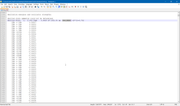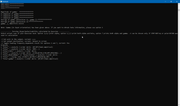Multiwfn forum
Multiwfn official website: http://sobereva.com/multiwfn. Multiwfn forum in Chinese: http://bbs.keinsci.com/wfn
You are not logged in.
- Topics: Active | Unanswered
Pages: 1
#1 Re: Quantum Chemistry » binding energies » 2021-01-27 03:22:13
I don't understand your meaning. You do not need to export shm file by Shermo, you can directly read thermal correction to G from output of Shermo.
Note that if you request Shermo to employ RRHO model (ilowfreq=0), then the thermal corrections printed by Shermo are identical to those by Gaussian.
Thank you sir, I was exporting shm file to read ZPE corrections as from text file of multiple entries Shermo don't print ZPE corrections. The exported shm file takes electronic energy value from Gausssian log file and not the value provided in text file input. Manually changing electronic energy value in shm file printed same results.
#2 Re: Quantum Chemistry » binding energies » 2021-01-26 08:48:07
This is a very common and standard way of calculating accurate Gibbs free energy.
However, if the system contains many low frequency modes, it is also important to apply quasi-RRHO thermodynamic model, which is supported by Shermo code (http://sobereva.com/soft/shermo/)
sir the result of G from text file is different from shm file generated by shermo.
I have given text file as input with content gaussian-freq-job.log;-2812.272184125518 and I got value of G as -2811.969688 au. then I gave shm file exported by shermo as input and I get value of G as -2812.4253519 a.u.
#3 Quantum Chemistry » Excitation energies are less than frontier orbital energies » 2021-01-24 11:55:13
- fyzan
- Replies: 1
Dear sir, the excitation energies are much less than frontier orbitals energy difference. like for excited state 1 the excitation energy is 5.0615 eV in the example file of N-phenylpyrrole.out present in Multiwfn example/excit folder but its HOMO (38)-LUMO (39) energy gap is 7.754761768 eV. How to explain these results?
#4 Re: Quantum Chemistry » binding energies » 2021-01-24 07:45:42
thanks professor, can the BSSE error energy from gaussian counterpoise method be also added to zero point and Gibbs free energies to get BSSE corrected Gibbs free energy?
#5 Re: Quantum Chemistry » binding energies » 2021-01-24 06:29:22
Not "change", you just need to compute Gibbs free energy for each configuation, and then directly compare the values.
To compute accurate Gibbs free energy, is this right approach to compute frequency at medium level and add thermal/entropy corrections from this medium level frequency calculation to the single point energy calculated at higher level? For example opt and freq job at pbe0/def2-tzvp and then add thermal/entropy corrections to single point energy computed at PWPB95 D3 def2-QZVPP level will yield better Gibbs free energy.?
#6 Re: Multiwfn and wavefunction analysis » Different oscillator strength of Multiwfn two-level & gaussian logfile » 2020-02-13 09:42:45
Thank you sir for your good advice.
#7 Re: Multiwfn and wavefunction analysis » Different oscillator strength of Multiwfn two-level & gaussian logfile » 2020-02-10 09:55:11
From the manual I get that we select dominant component i.e Z and we have to report only Z component of transition dipole moment (Oscillator strength) and variation of dipole moment as BetaZZZ based only on Z component. we don't need to report total oscillator strength/tot transition dipole moment for the sake of discussion in two level model?did I get this correct or I'm making any mistake?
#8 Re: Multiwfn and wavefunction analysis » Determination of crucial excited state for two-level model » 2020-02-10 07:59:45
Sir to properly orient should we orient dipole moment of the molecule along Z axis to get significant component of beta as betaZZZ?
#9 Multiwfn and wavefunction analysis » Determination of crucial excited state for two-level model » 2020-02-10 05:09:57
- fyzan
- Replies: 3
Hi Dear professor Lu, in your work J. Comput. Chem., 38, 1574 (2017) it is reported that crucial excited state corresponds to the lowest-lying one with large oscillator strength, whereas in Multiwfn manual "4.200.8.2 Perform two- and three-level model analysis for first
hyperpolarizability of NH2-biphenyl-NO2" excited state with larger magnitude of "Tot" (norm of transition dipole moment) is considered as crucial excited state. Are these two statements always results in same excited state? if they corresponds to different states then which one to prefer?
if we are considering BetaXXX and excited state having highest Tot" (norm of transition dipole moment) has low transition dipole component in X direction as compared to another state having low Tot" (norm of transition dipole moment) but higher transition dipole component then which state should be considered crucial excited state?
another confusion i have is that "Variation of dipole moment component" outputted by Multiwfn should be reported or the Variation of dipole moment calculated by finding difference in ground state and excited state with density=current keyword in gaussian?
thanks
#10 Multiwfn and wavefunction analysis » Different oscillator strength of Multiwfn two-level & gaussian logfile » 2020-02-10 04:15:36
- fyzan
- Replies: 4
#11 Re: Multiwfn and wavefunction analysis » Multiwfn gamma support » 2020-02-04 13:32:29
Thank you, sir for the explanation
#12 Re: Multiwfn and wavefunction analysis » Multiwfn gamma support » 2020-02-02 23:15:58
Thanks sir, it works now. One more question sir, which value is more important to discuss magnitude of beta/gamma or beta || and gamma ||?
#13 Re: Multiwfn and wavefunction analysis » Multiwfn gamma support » 2020-02-01 16:48:29
Dear professor Lu, I have emailed you input and output files. I'm using Multiwfn version released on 2020-Jan-24.
#14 Multiwfn and wavefunction analysis » Multiwfn gamma support » 2020-02-01 09:45:25
- fyzan
- Replies: 6
#15 Re: Quantum Chemistry » Check for the thermal stability of a 2D structure » 2020-01-27 14:39:43
Thanks it works, I was incorrectly pasting for 18 atoms while my structure has 12 atoms only
#16 Re: Quantum Chemistry » Check for the thermal stability of a 2D structure » 2020-01-27 14:17:57
Sir after pasting above code in VMD console I get this error "ERROR
invalid atom id
invalid atom id"
#17 Re: Quantum Chemistry » Check for the thermal stability of a 2D structure » 2020-01-27 11:22:39
sir I have successfully produced the RMSD curves. I'm fist time doing AIMD and learning from your paper. sir do you have any script for Fig. 26 Variation of all the eighteen C-C bonds in your paper? are the bondlengths are calculated manually after every 20 fs?
#18 Re: Quantum Chemistry » Check for the thermal stability of a 2D structure » 2020-01-26 13:27:21
Thanks a lot Sir for the help.
#19 Re: Quantum Chemistry » Check for the thermal stability of a 2D structure » 2020-01-26 12:03:52
Dear Professor Tian LU,
sir can you please provide instruction for how to draw the figure of Root mean square deviation (RMSD) with respect to its optimized structure from AIMD simulations as shown in fig. 24 of your research paper "A thorough theoretical exploration of intriguing characteristics of cyclo[18]carbon: Geometry, bonding nature, aromaticity, weak interaction, reactivity, excited states, vibrations, molecular dynamics and various molecular properties"
Thanks in advance
#20 Re: Quantum Chemistry » Gaussian 16 alternative for calculating first hyperpolarizability » 2020-01-26 11:56:12
ok Thank you very much sir
#21 Quantum Chemistry » Gaussian 16 alternative for calculating first hyperpolarizability » 2020-01-26 00:19:36
- fyzan
- Replies: 4
Dear Professor Tian LU,
I want to know are there any other code (preferably periodic DFT code like CASTEP, Quantum espresso etc) that can calculate polarizability and first hyperpolarizability like gaussian 16?
Thanks
Pages: 1


